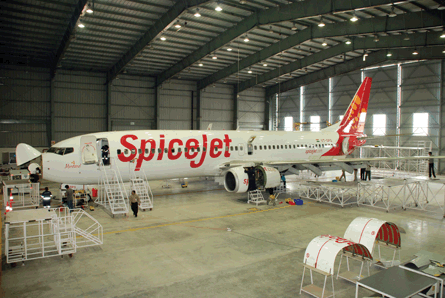India is often viewed as a potentially large maintenance, repair and overhaul market in Asia, given its geographical location and the rapid growth of its airlines over the past decade.
Yet, while the larger carriers such as Air India and Jet Airways have their own facilities to conduct the entire slew of checks and offer a variety of services, many of the other carriers go to neighbouring countries including South-East Asia for their heavy checks.
Third-party MRO facilities could offer one solution and there has been much talk over the past few years about joint ventures and third-party maintenance houses. Air India and Airbus, for example, wanted to build an MRO facility for narrowbody aircraft, while the carrier also considered a GEnx/GE90 engine repair facility together with GE. Kingfisher Airlines had mulled over a maintenance facility with Gulf Aircraft Maintenance, while Boeing talked of an MRO hub in Nagpur.
These projects were either put on the shelf or delayed as economic downturn bit and the airlines began to suffer heavy losses. The aim, in this time, has been to focus on their core businesses. As a result, while most of them perform their own line maintenance at home, the heavy maintenance is often outsourced to companies in other parts of Asia.
 |
|---|
© Air WorksAir Works is maintaining SpiceJet aircraft and hopes EASA approval will help it expand |
That has paved the way for domestic MRO firm Air Works, which started operations in 1951 catering to the general aviation and business aviation markets, to step into the fray. The company, which is based at Mumbai International airport and has facilities in nine other airports in the country, already has authorisations to perform maintenance on AgustaWestland, Bell Helicopter, Bombardier and Gulfstream aircraft, and Honeywell engines.
A few years ago, however, its management decided to expand into the commercial aircraft segment and began to work towards that. "It was a natural extension for a company that has had a long history in the Indian aviation industry," says executive director and head of business development Ravi Menon, the son of one of the company's two founders.
In November 2008, the company received approval from India's Directorate General of Civil Aviation for its commercial MRO services in Hosur, a city in the southern state of Tamil Nadu. That made it the first the country's first independent airline MRO, and allowed it to perform services such as line and base maintenance, aircraft painting, structural repairs, cabin upgrades, and avionic upgrades. Air Works also offers component repairs and spare parts sourcing.
THIRD-PARTY FIRST
In October, it became the first company to offer third-party MRO services in India after receiving its European Aviation Safety Agency certification earlier this year.
The certification for its facilities at Hosur is the first time that an Indian airframe MRO company has received the EASA repairs station approval. It allows Air Works to service aircraft from all over the world, although the focus will remain on India for now.
"The certification will not only help us capture more market share here, but also look for business internationally in places as far as Europe," says Menon, a licensed aircraft maintenance engineer and a certificated pilot. "We are already doing work for domestic airlines like SpiceJet, and this can easily be extended to other carriers."
Fredrik Groth, chief executive of Air Works, adds that the certification would help carriers take advantage of India's highly skilled workforce and cost advantage. "The EASA approval further demonstrates that India is able and ready to compete with the world in this multi-billion dollar industry. We trust the domestic and the international airlines will find value in our maintenance services, and we look forward to lowering costs for the airlines," he says.
The approval covers airframe and component maintenance on ATR 42/72 -500 aircraft and Boeing Next Generation and Classic 737s. Air Works says that it intends to add Airbus A320 capability in the coming months. It says there are almost 500 737s and over 100 ATRs operating in India and neighbouring countries.
Earlier this year the company also signed a letter of intent with SuperJet International to become the authorised service partner for the Sukhoi Superjet 100 regional jet in India. It will offer MRO services for the aircraft at Hosur.
The Hosur facility has one hangar capable of housing two ATR 72-size aircraft or one narrowbody. The company, which is partly owned by Indian engineering firm Punj Lloyd and US private equity firm Global Technology Investment, plans to raise another Rp1.8 billion ($38.7 million) by either selling equity or through debt in the near future.
These funds will be used to build an additional hangar - possibly one dedicated to widebody aircraft - by the end of 2010, and a facility for engines and components MRO activities as part of its plans to offer a wider range of services to the airlines in the region.
ANGLO-INDIAN JOINT VENTURE
Air Works has also formed an Indian joint venture with the UK's Air Livery - one of the largest paintshops in Europe. This joint venture is India's first dedicated paint facility for both narrowbody and widebody aircraft. It will offer regular painting maintenance and tip-to-tail livery change for aircraft up to the size of the Boeing 777-300.
The facility will have state-of-the-art temperature humidity control and extraction systems, says the company. This service will initially be offered at Hosur and could later be extended throughout India and Asia Pacific.
"Without an in-house MRO capacity, airlines have no choice but to send their aircraft abroad. As a result, not only do they have to suffer from foreign exchange fluctuations, they also have a higher loss of revenue as the aircraft is out of service much longer," says Menon.
"Given that we have the EASA and DGCA certification at the Hosur facility, airlines can cut their maintenance costs, which account for a major expense. That is especially important in this economic climate."
Source: Flight International



















